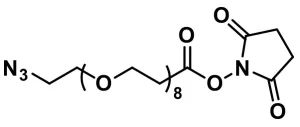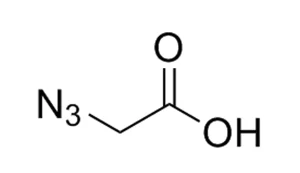Description
Azido-dPEG®4-TFP ester, product number QBD-10567, is a crosslinking compound designed for copper(I)-catalyzed, ruthenium catalyzed, and strain promoted click chemistry (CuAAC, RuAAC, and SPAAC, respectively). The two ends of the molecule are separated by a short (16 atoms), single molecular weight, discrete polyethylene glycol (dPEG®) spacer. The spacer imparts water solubility to QBD-10567 and increases the hydrodynamic volume of the conjugate molecule. The azide group provides the click chemistry functionality, while the 2,3,5,6-tetrafluorophenyl (TFP) ester reacts primary and secondary amines. The single molecular weight and discrete chain length of the spacer simplifies analysis of the product and of its conjugates.
TFP esters are an alternative to the widely popular N-hydroxysuccinimidyl (NHS) esters. TFP esters are more hydrolytically stable than NHS esters, and their optimal reaction pH range (7.5 – 8.0) is somewhat higher than NHS esters (7.0 – 7.5). Moreover, TFP esters in their optimal pH range are more reactive toward free amines than NHS esters.
References
Greg T. Hermanson, Bioconjugate Techniques, 2nd Edition, Elsevier Inc., Burlington, MA 01803, April, 2008 (ISBN-13: 978-0-12-370501-3; ISBN-10: 0-12-370501-0). Specifically see pp. 726-729 in his Chapter 18 on discrete PEG compounds for pegylation applications.
Greg T. Hermanson, Bioconjugate Techniques, 3rd Edition, Elsevier, Waltham, MA 02451, 2013, ISBN 978-0-12-382239-0; See chapter 18, Discrete PEG Reagents, pp.787-821, for a full overview of the dPEG® products.





